43
Learning Goals
By the end of this reading, you should be able to
- Order the events that lead to the current adaptations of terrestrial tetrapods
- Describe key adaptations that allow for support in terrestrial environments
- Explain how changes in vertebral structure lead to the current mobility of terrestrial tetrapods
- Delineate between ancestral and derived traits of tetrapods
Introduction
The word “tetrapod” means “four feet” and includes all species alive today that have four feet — but this group also includes many animals that don’t have four feet. That’s because the group includes all the organisms (living and extinct) that descended from the last common ancestor of amphibians, reptiles, birds, and mammals. So, for example, the ichthyosaur, an extinct swimming reptile, is a tetrapod even though it did not use its limbs to walk on land. Snakes are also tetrapods even though they do not have limbs. Birds and humans are tetrapods even though they only walk on two legs. All these animals are tetrapods because they descend from the tetrapod ancestor.
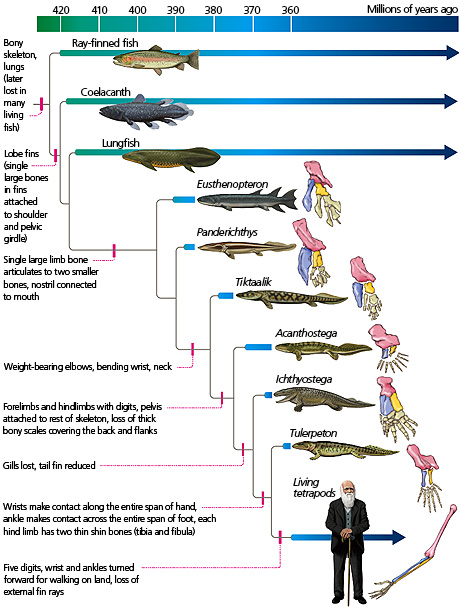
Characteristics of fish ancestors
Most 25,000 living species of animals that we call fishes are ray-finned fishes. There in fact far more of these types of fishes than all the other vertebrates combined. The fins of these fish have a unique structure— that is, they have a system of often branching bony rays (called lepidotrichia) that emanate from the base of the fin. In contrast, the other animals in the phylogenetic tree — coelacanths, lungfishes, all the other extinct animals, plus tetrapods (represented by Charles Darwin) — have what we call “fleshy fins” or “lobe fins.” That is, their limbs are covered by muscle and skin. Some, such as coelacanths, retain lepidotrichia at the ends of these fleshy limbs, but in most fleshy-finned animals these have been lost.
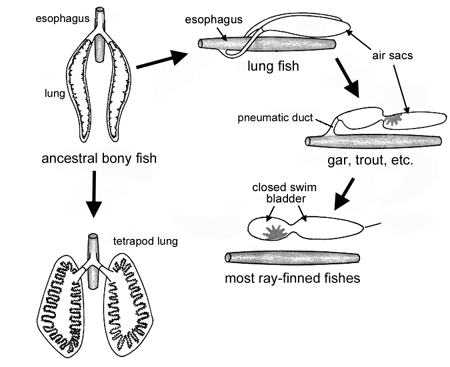
The common ancestor of all those different organisms (ray-fins, coelacanths, lungfishes, tetrapods, etc.) was neither a lobe-fin nor a ray-fin. This ancient vertebrate lineage had fins (with lepidotrichia), scales, gills, and lived in the water. Yet they also had air bladders (air-filled sacs) connected to the back of their throats that could be used for breathing air (i.e., as lungs) or for buoyancy control. The air bladders of many current ray-finned fish no longer connect to their throats, and so they are not able to breathe air. In these ray-fins, the air bladder is used mainly for buoyancy control and is known as a swim bladder. By contrast, tetrapods have taken an alternative route: they have lost the buoyancy control function of their air bladders, and instead, this organ has been altered to form the lungs that we all rely on to provide gases on land.
When we get past coelacanths and lungfishes on the phylogenetic tree, we find a series of fossil forms that lived between about 390 and 360 million years ago during the Devonian Period. During this interval, this lineage of fleshy-finned organisms evolved adaptations that allowed them to leave the water and begin to live on land. Many of these adaptations involved parts of the skeleton that were altered to both structural support and locomotion in a terrestrial environment.
Review Question:
Changes to the skeletons
The ancestors of the tetrapods lived fully in the water and had skulls that were tall and narrow, with eyes facing sideways and forwards. This allowed them to look around in their watery environments for predators and prey. However, as ancestors of the first tetrapods began to live in shallower waters, their skulls evolved to be flatter, with eyes on the tops of their heads. This probably allowed them to look up to spot food. Then, as tetrapods finally moved fully onto land and away from the water, many lineages once again evolved skulls that were tall and narrow, with eyes facing sideways and forwards, allowing them to look around their terrestrial environments for predators and prey.
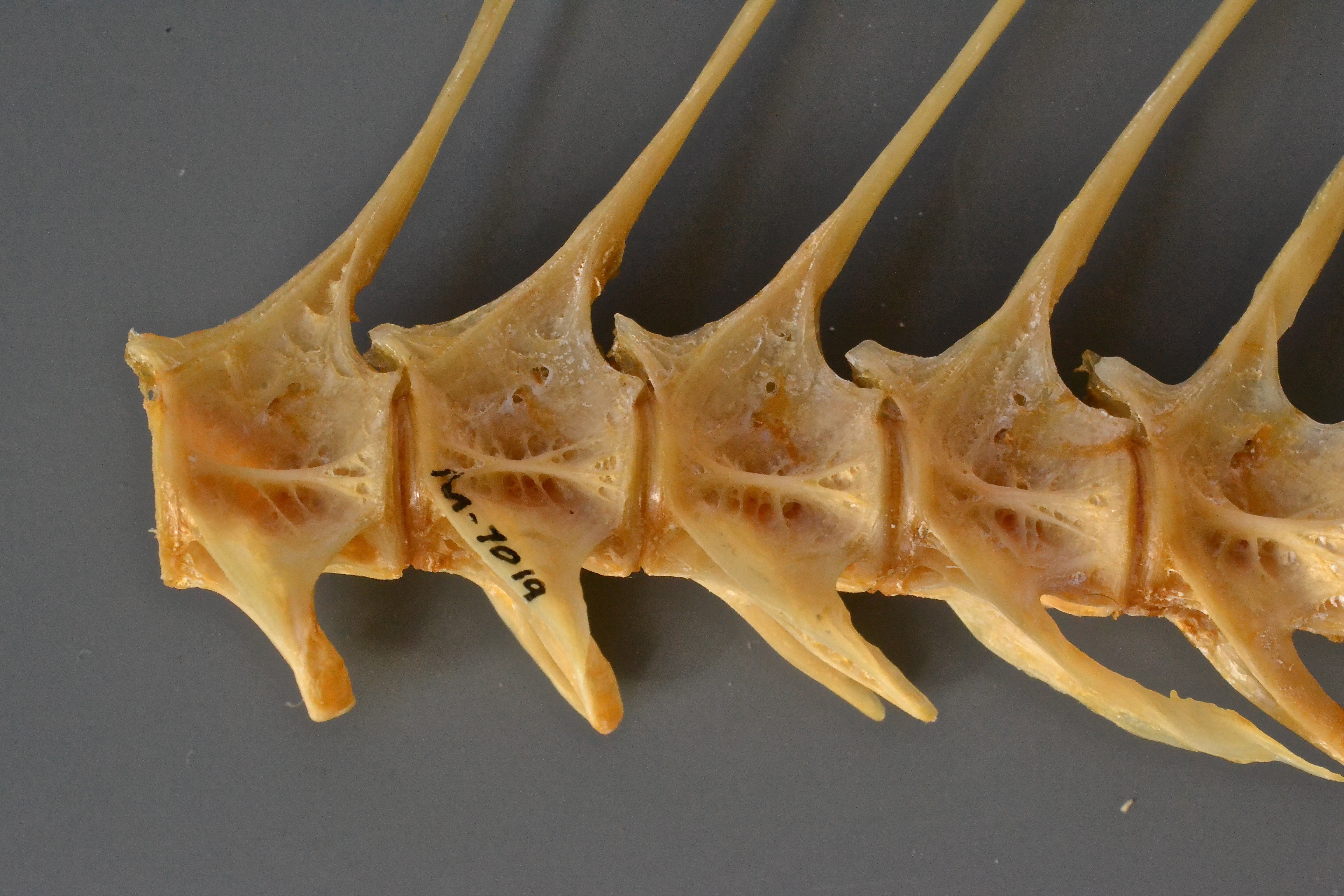
As lineages moved into shallower water and onto land, the vertebral column gradually evolved as well. You may have noticed that fishes have no necks. Their heads are simply connected to their shoulders, and their individual vertebrae look quite similar to one another, all the way down the body. In shallow water dwellers and land dwellers, the first neck vertebra evolved different shapes. This adaptation allowed greater movement of the vertebrae and thus made it possible for these animals to move their heads up and down. Eventually, a second modification of the neck vertebra occurred that made it possible for a group of these animals to move their heads left and right. Mobile necks allow land animals to look down to see the things on the ground that they might want to eat and to watch for predators. Later tetrapods evolved necks with seven or more vertebrae, some long and some short, permitting even more mobility.
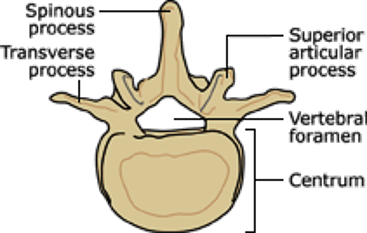
The vertebrae you are probably most familiar with (like our own!) consist of a spool-like centrum, which connects in front and back with other centra. On top of the centra are vertebral spines and arches to which muscle segments attach, and lateral to the centra are the ribs; these anchor muscles that flex as the animals move. Fishes swim with simple lateral motions, so their arches are relatively straight and needle-like, and so are their ribs. When you eat fish and pick out the bones, these are mostly what you’re finding. Because fishes live in the water, gravity is not a big problem for them. But on land, a quadruped with a backbone between forelimbs and hindlimbs faces the same problems as a bridge designer: sag. As the fleshy-finned organisms began to venture onto land, they evolved a series of interlocking articulations on each vertebra, which helped them overcome sag and hold the backbone straight with minimal muscular effort.
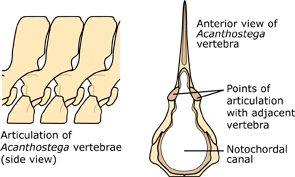
The connection between the pelvis and hindlimbs in early tetrapods is a prime example of exaptation. We call this fused connection the sacrum. It is extremely useful for terrestrial organisms because it allows them to use their hindlimbs efficiently for locomotion on land. Since the aquatic ancestors of fishes and tetrapods had no such connection, one might guess that this feature first evolved serving the function of enabling terrestrial locomotion. However, the earliest form of this connection (as seen in Acanthostega) evolved while these tetrapod precursors were still living in the water. Based on current evidence, Acanthostega appears to have been fully aquatic, so this connection likely evolved to function in something other than terrestrial locomotion. Only later, as tetrapod ancestors moved onto land, was this trait co-opted for terrestrial support — and as it was, additional vertebrae were fused in the same way, providing further support.
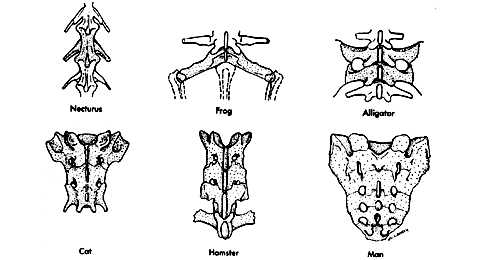
As the limbs and their connections to the rest of the skeleton evolved, limb bones took on distinct roles and many bones were lost. The humerus and the femur were already connected to two outer bones (the radius and ulna in the forelimb, the tibia and fibula in the hindlimb). This is something that evolved about 30 million years before vertebrates came onto land. However, muscular connections between these bones began to change on the road to land and allowed the limbs to be used for terrestrial locomotion. The ankle was originally composed of many small bones arranged in two rows, but gradually many of these small bones were lost. The first animals to get close to walking on land had eight digits on each limb. Over time, some of these digits were lost, leading to animals with seven digits, then six, and then five, which is the common condition now seen in living tetrapods.
Review Question:
Other adaptations to land
As these animals evolved to live on land, other changes in the rest of their bodies evolved. Many would eventually lose their gills, which only work well for getting oxygen when wet, and their tail fins got smaller. Similarly, they lost the lateral line system, a network of vibration-sensitive canals along the skull and jaw, which doesn’t work out of water.
The environments of the animals also changed through time. In fact, if you were to venture back to Arizona at the beginning of the “Age of Dinosaurs” in the Triassic Period, some 225 million years ago, you would find ray-fins, coelacanths, and lungfishes living in the marshes, streams, and temporary ponds of that day, along with freshwater sharks. So the habitats that these animals occupy today are not necessarily the ones in which they have always lived, or in which they originally evolved. It is still unclear exactly where the transition from water to land took place ecologically. Paleontologists have discovered fossils involved in this transition preserved from freshwater, brackish, and marine habitats. Regardless of where the transition occurred, eventually, early ancestors of the first tetrapods came up onto land — although not all stayed. Some, like the whales, made the transition back into the water.
Click here to learn more about the origin of the four-legged vertebrates: https://youtu.be/zK8XGEDcTfo
Summary
All modern-day tetrapods share a common ancestry that begins with the fish. It is likely that some ancestral fishes evolved the capacity to breathe air and to move out of the water. The terrestrial environment required changes in the structures of the bones that provided support as well as those involved in the mobility of the organism. Additional adaptations that altered bone morphology and physiological processes occurred as new environments on land were entered.
End of Section Review Questions:
Thinking About It: Changes in bone shapes
Thinking about it: Changes to bone numbers

